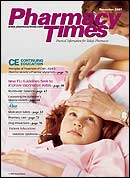ASTHMA WATCH
Breast-feeding and Weight Linkedto Risk of Asthma
New research shows that children who are breast-fed forfewer than 3 months and who are overweight have agreater risk of developing asthma. In a study of >700 childrenaged 8 to 10 years old, researchers found that thecombination of being breast-fed for fewer than 12 weeksand excess weight gain in childhood raised a child's asthmarisk by 80%.
The duration of breast-feeding was not a factor on itsown, however. The investigators speculate that the shorternursing time could be a factor in the extra weight gain of thechildren, which in turn raised their asthma risk. The findingswere published in the September 2007 issue of the Journalof Allergy and Clinical Immunology.
The general standard for breast-feeding is to nurse exclusivelyfor the first 6 months, then combine nursing withsolid foods for at least 12 months. Parents in the study wereasked about breast-feeding and other factors in the child'senvironment. They found that short-duration breast-feedingwas linked to the risk of the children becoming overweight,and these children had a greater risk of asthma.
New Guidelines EmphasizeDisease Control
The National Heart, Lung, and Blood Institute (NHLBI) issuednew guidelines for asthma that are aimed at helping patientsbreathe easier and maintain an active lifestyle. Elizabeth G.Nabel, MD, director of the NHLBI, stated that, with propermedical care, healthy environments, and better informedpatients, asthma can be controlled and patients can leadactive lives. "As health care providers and patients, we reallyshould accept nothing less," she said.
The guidelines call for a stronger emphasis on asthma monitoring,which should focus on the severity of a patient's symptomseach day. Both patients and doctors need to be aware ofdaily symptoms, as well as the risk of future attacks, loss oflung function, and side effects from medication.
The guidelines also established revised patient age categories:infants to 4 years old; 5 to 11 years old; and 12 yearsand older. The 5- to 11-year-old group, once combined withthe adult group, was formed after new evidence showed thatthis age group responds differently to asthma medicationthan adults do. The NHLBI also encourages schools to allowchildren to bring their rescue inhalers to school.
Parents? Anxiety over Meds Hampers Treatment
Parents who are overly concerned about the side effectsof their children's asthma medications may be withholdingthem unnecessarily, depriving children of much-neededsymptom relief. According to the results of a study at theUniversity of Rochester Medical Center, 1 in 6 parents ofchildren with asthma is more concerned about the sideeffects of asthma medications than a child's need for them.Approximately 10 million children in the United States haveasthma, yet only half of them take their prescribed medicationsdaily as directed. The findings were published in theSeptember 2007 issue of Pediatrics.
Researchers interviewed the parents of 622 children whoreported using at least 1 preventive asthma medication.The parents completed a "Beliefs About Medication" questionnaire,which compared the parents' belief in the needfor medication with their concerns about taking it on a regularbasis. These concerns included the possibility of sideeffects or that the drug might be habit-forming.
Even though 77% of the parents felt that the need for themedicine outweighed any concerns they may have hadabout it, 17% still believed that the medication could do moreharm than good to their children. About 6% were undecided.
Use of Spray Cleaners Can Raise Asthma Risk
Using household spray cleaners andair fresheners, even as little as once aweek, can raise the risk of developingasthma in adults. These products havebeen associated with higher asthmarates in professional cleaners, but thiswas the first study to focus on nonprofessionaluse of these products.
Investigators from the Centre forResearch in Environmental Epidemiologyat the Municipal Institute ofMedical Research in Barcelona, Spain,used baseline data from the first phaseof the European Community RespiratoryHealth Survey and interviewsconducted during the follow-up phase.The study included more than 3500patients across 22 centers in 10European countries who were assessedfor current asthma, currentwheeze, doctor-diagnosed asthma, andallergy at follow-up, an average ofabout 9 years after initial assessment.The patients were asked to report howoften they used cleaning products.
The risk of developing asthmaincreased with the frequency of exposureto different cleaning productseach week. The average was in therange of 30% to 50% higher in peoplewho were regularly exposed to cleaningsprays than those who were not.The researchers found that glass cleaners,furniture polishes, and air freshenerstended to have the strongest effect.The findings were published in the secondOctober (2007) issue of theAmerican Journal of Respiratory andCritical Care Medicine.
F A S T F A C T : Asthma is the leading cause of school absenteeism attributed to chronic conditions in children.

